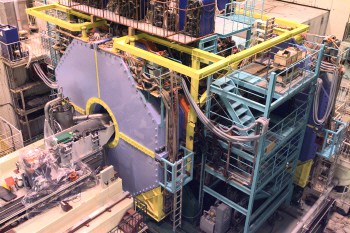The famous Bell’s inequality of quantum mechanics has been tested in a high-energy particle physics experiment for the first time. The inequality was violated by three standard deviations in experiments with B mesons at the KEK laboratory in Japan – yet again confirming the predictions of quantum theory (arxiv.org/abs/quant-ph/0310192; J. Mod. Optics to be published). Previously most Bell’s inequality experiments have been performed with photons or ions.

Experiments to test Bell’s inequality involve measuring the properties of pairs of particles that are space-like separated in the sense of special relativity: in other words, there is no time for a light signal to travel between them within the duration of the experiment. In a typical Bell’s inequality experiment the polarizations of a pair of photons are measured as the relative angle between the axes of polarizers making the measurements is varied.
Quantum mechanics predicts that “non-local” correlations can exist between the particles. This means that if one photon is polarized in, say, the vertical direction, the other will always be polarized in the horizontal direction, no matter how far away it is. However, some physicists argue that this cannot be true and that quantum particles must have local values – known as “hidden variables” – that we cannot measure.
Bell and others showed that it was possible to distinguish between quantum mechanics and these hidden-variable theories in a certain type of experiment that measure a parameter known as S. Put simply, the local theories predict that S will always be less than two, whereas the quantum prediction is S = 2√2. When S is greater than two, Bell’s inequality is said to be violated.
Apollo Go of the National Central University in Taiwan and co-workers in the Belle collaboration performed the experiment at the KEK B-factory. At this accelerator beams of electrons and positrons are collided to produce pairs of B mesons and their antiparticles, which then decay into lighter particles. The meson pairs behave like photon pairs, but instead of analyzing correlations between directions of polarization, the Belle team study particle-antiparticle correlations using a technique known as “flavour tagging”. Go and colleagues calculated that S = 2.725, with error bars that mean that the inequality is violated by three standard deviations.
“If quantum mechanics is the fundamental description of nature, then non-local correlations should be found with any quantum number,” Go told PhysicsWeb. “In this experiment we are testing a quantum number that has never been tested before. Moreover, the particle-antiparticle quantum number is a very fundamental quantity in particle physics and the results might have implications in this area – I am waiting for comments from other particle theorists!”
The team now plans to study particle-antiparticle correlations in more detail and probe the boundary between classical and quantum mechanics.



